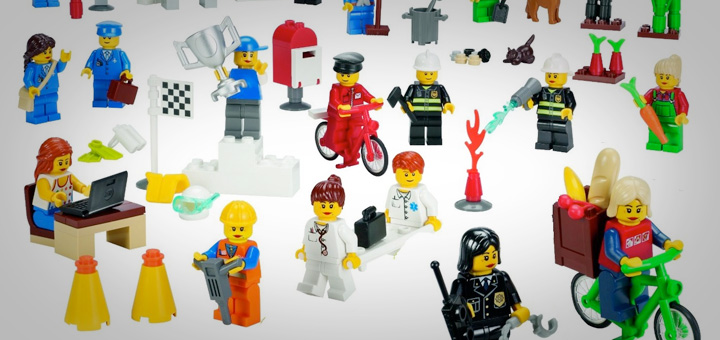Easily one my favourite brainstorm techniques, New Point of View is a classic mental excursion.
Excuse me, excursion?
A creative excursion is not a literal journey but a mental one. Based on a specific problem to be solved, a facilitator uses an excursion to first ask brainstormers to think of as many possible responses to a question or a situation – sometimes even a response to an item (not unlike free association).
Next, using the original problem and the random answers, the group bends or merges the two different items together into a new unique third idea. (This merging is also called a force-fit in creative vocabulary. It’s also not that far removed from metaphors and analogies.)
The more disparate the two random items, the greater likelihood of a far more unusual idea.
For New Point of View, the random items are occupations.
How To Use This Technique
Here’s how New Point of View works.
1. State the initial problem preventing the objective or outcome from being achieved. It might also be an opportunity to leverage.
Example: How do we get employees to notify the head office when an external event might turn into an issue or crisis?
Alternatively, re-frame the problem or opportunity.
Example: What early warning or preventative device could we use internally to alert our company of a potential issue or crisis?
2. Using the list of random, unrelated occupations at the bottom of this article, ask how any specific occupation might solve your problem from a new point-of-view?
- A politician uses public polls to turn to in an issue or crisis
- A chef uses a clock timer
- A lifeguard uses flags
- An orchestra conductor uses a baton
- A policeman uses a speed camera.
3. Bend or adapt any of the occupation’s items to your problem.
- Public polls could become reviewing ongoing customer service calls or feedback to see if there’s any problems arising
- The clock timer could be translated to monthly reviews among sales staff to check if any new problems are arising among existing or potential customers
- And so on …
Another variation is to focus on one specific occupation. Here’s the same Point-of-View exercise using a farmer.
1. What early warning or preventative devices would a farmer use?
- A veterinarian to prevent potential disease in the animals
- A cattle dog to signal of wild animals
- A weather vane to show sudden changes in the weather
- A scarecrow in the fields to scare off crows
- A broad-brimmed hat to protect the head from a strong sun.
2. Next, transfer the metaphor to the original problem or opportunity.
- Using Vet/Doctor: Can we appoint an expert outside the organization to help, or assign people inside the organization to become our experts?
- Using Animals: Can we create a mascot for the “early-warning campaign,” such as a St. Bernard?
- Playing with the idea of weather vanes, our client loved the idea of using the vane icon – especially the direction initials which spell out ‘NEWS’ – to create a special email newsletter to educate its customers about examples and suggestions on how to engage the head office for support during issues or crises management.
A few final suggestions.
Don’t get stuck on a specific occupation. If it doesn’t stimulate idea, or is no longer useful, quickly move on to another, and another.
Adapt and add to the occupations list with others which may be more relevant – or irrelevant – than the list below.
Re-create the list of occupations into a list of famous people, whether they are historical, fictional, current, or even celebrities.
If you have access to toys, you can combine New Point of View into a bigger excursion. Using my 2,000-piece LEGO Serious Play set, I had brainstormers choose a mini LEGO person and build out any occupation they like, or if they feel particularly creative, to create a mini-landscape for their people/occupations. After 10-15 minutes, we put all of the completed “toys” in the centre, and brainstormed ideas to fit the business problem or situation.
Have you used metaphors or free association as brainstorm techniques? How have you used them? Please add your thoughts and comments below.
An Initial List of People To Give you A New Point-of-View
I’ve used many occupations as thought-starters, but here’s a list I’ve compiled on jobs which tend to work nicely, because they’re descriptive and the job itself has lots of tasks or responsibilities. If it’s easier, click here for a PDF of the list.
Accountant
Activist
Actor
Advertising Executive
Air Traffic Controller
Airline Pilot
Animal Trainer
Architect
Astronomer
Author
Babysitter
Baker
Bartender
Bus Driver
Butcher
Cameraman
Carpenter
Chauffeur
Chef
Chief Executive Officer
Child Care Worker
Choreographer
Cleaner
Clergy
Coach
Computer Technician
Concierge
Conductor
Construction Worker
Costume Attendants
Crossing Guard
Curator
Dentist
Dietitian/Dietician
Dishwasher
Diver
Electrician
Embalmer
Engineer
Farmer
Film Director
Fire Fighter
Fitness Trainer
Flight Attendant
Florist
Foreign Language Teacher
Funeral Director
Gardener
Geographer
Graphic Designer
Groundskeeper
Hairdresser
Historian
Illustrator
Industrial Engineer
Insurance Salesman
Interior Designer
Jewelers
Journalist
Lawyer or Solicitor
Librarian
Lifeguard
Maid
Manicurist
Marriage Counselor
Meeting Planner
Model
Nuclear Engineer
Nurse
Optometrist
Pediatrician
Pharmacist or Chemist
Photographer
Physical Therapist
Plumber
Policeman
Private Detective
Psychiatrist
Radio DJ
Rancher
Real Estate Agent
Receptionist
Referee
Restaurant Hostess
Roofer
Scientist
Sculptor
Secretary
Ship Captain
Social Worker
Statistician
Stonemason
Surgeon
Tailor
Taxi Driver
Teacher
Telemarketer
Tour Guide
Travel Agent
Veterinarian
Waiter/Waitress
Woodworker
Zookeeper



1 Comment
Thank you for these invaluable ideas, Andy!
I would, of course, suggest Singer and Translator for your list… 😀
All the best, always,
bj